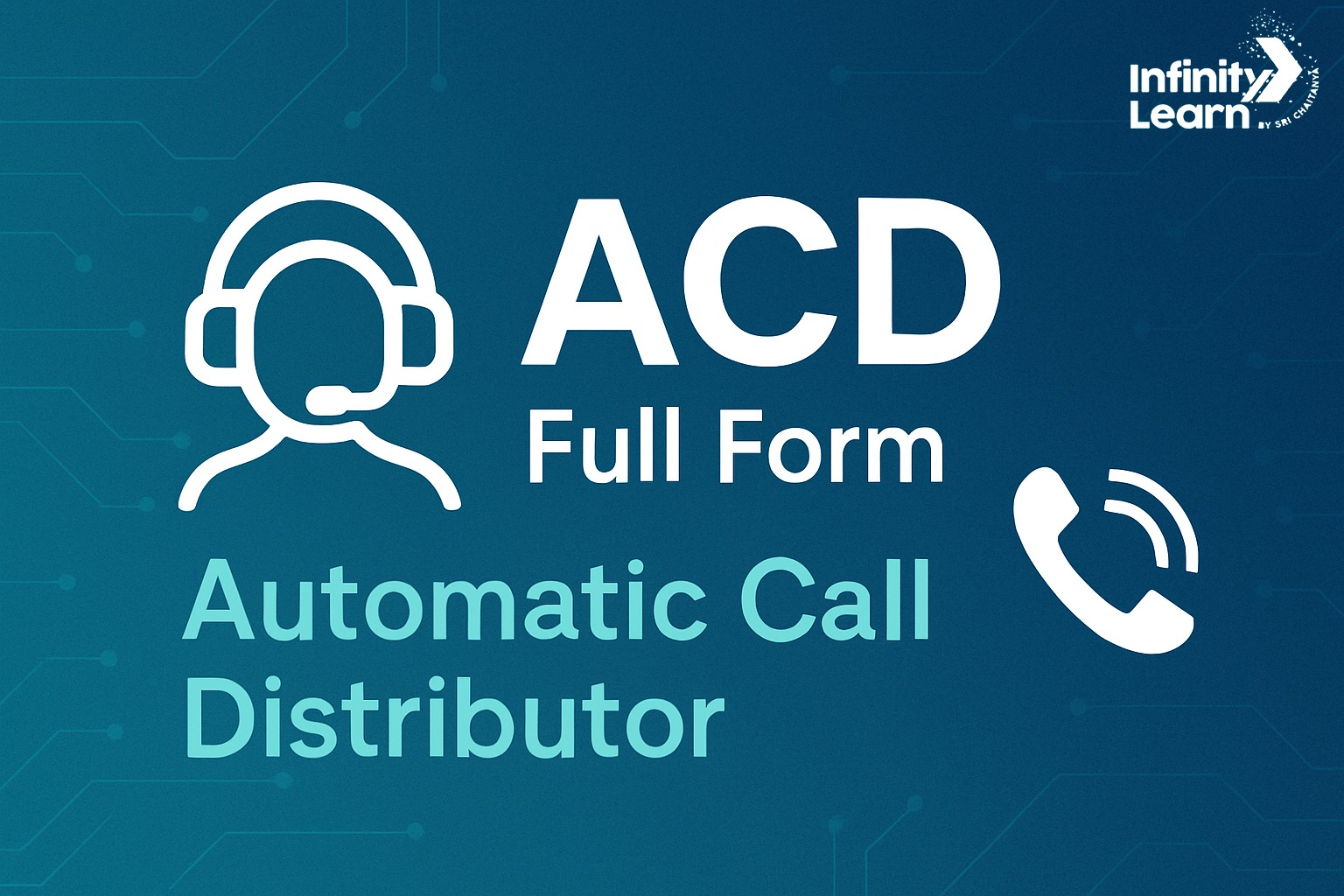Table of Contents
The ACD Full Form is Automatic Call Distributor
Automatic Call Distributor (ACD) is the technology incorporated in the telephony system at call centers that connects the caller to the right representatives. If you have ever wondered how call centers manage so many calls simultaneously; it’s the ACD that routes all calls to the most suitable agents.
The ACD acts as a traffic controller to streamline the workflow and avoid incoming call chaos. This blog explores how ACD can identify callers’ needs and help them reach the appropriate agents or departments using some intelligent mechanisms, reducing wait times and keeping customers satisfied.

What is the Full Form of ACD?
The full form of ACD is ‘Automatic Call Distributor‘ where:
A Stands for Automatic
C stands for Call
D stands for Distributor
ACD is a system that becomes most useful in call center settings. It effectively handles the large volume of incoming calls by routing each call to the most suitable agents. A call center may receive several calls on a variety of issues.
The ACD recognizes the nature of incoming calls and transfers them to specific departments or customer service agents. The purpose is to generate faster responses to customer queries and enhance their experience.
Do Check: List of all Important Full Forms
ACD Features That Improve Call Routing
An ACD has features that make the call-handling process more streamlined and efficient. It also makes customer interactions smoother and optimizes agent performance. Let’s discuss the main features of ACD:
- Skill-based Routing: The ACD directs incoming calls to agents with the necessary skills, expertise, and abilities to appropriately address customer needs. This process improves the chance of quick issue resolution and satisfies customers.
- Time-based Routing: This feature allows call distribution according to agents’ availability. The call assignments are aligned to agent schedules, improving productivity and efficiency.
- Predictive Routing: ACDs use mechanisms to track and analyze call patterns and intelligently direct incoming calls to the most suitable agents. This proactive approach reduces customer wait times.
- Interactive Voice Response (IVR) Integration: Automatic call distributors integrate with IVR technology that gathers caller data and connects customers to the appropriate agent or department based on this information.
Call Queue Management
ACD’s queue management system organizes call distribution in a way that handles multiple calls simultaneously and also manages agent workloads efficiently.
Real-time Analytics
Automatic call distribution systems use analytics to track call trends, agent performance, and customer responses. These data help identify improvement areas to enhance call handling and customer satisfaction.
Must Read: BCG Full Form
History of ACD
The ACD has evolved over the years to improve its versatility and effectiveness. Let’s look at the journey of ACD and its important milestones.
- 1970s: ACD systems were developed to replace manual switching techniques. These systems allowed call transfer to agents sequentially.
- 1980s: The system became more advanced with skill-based routing that distributes calls according to operators’ skills.
- 1990s: ACD systems were integrated with computer systems, resulting in better data handling and faster responses based on customer needs.
- 2020s: ACD integrated AI to manage call routing and utilized predictive analysis to optimize call assignment and agent performance.
How Does ACD Work?
ACD works through some systematic steps as explained below:
- Call Receiving: The first step is receiving an incoming call.
- Caller Identification: The system identifies the caller through phone numbers and other information.
- Call Queueing: The call is placed in a queue before being redirected.
- Call Routing: Based on the type of Call, the ACD routes the call to the most suitable person who can handle it efficiently.
- Call Transfer: If the initial agent cannot attend, the call is transferred to another qualified agent without delay.
- Call Monitoring: The ACD tracks call duration, resolution time, and other metrics to optimize call handling.
- Post-call Processing: ACD analyses data on call and response patterns for future reference and improvement.
ACD Strategies for Call Routing
The core purpose of ACD is to direct the call for the most efficient outcomes. It uses different strategies to serve this purpose. Here are some common approaches:
- Round-robin: Calls are distributed to agents sequentially as per a predefined order.
- Skill-based: ACD helps to assign calls to agents who have the required skills and experience to handle specific issues.
- Longest idle agent: This method identifies the agent waiting too long to take a new call.
- Least occupied agent: This method assigns the Call to the active agent for the shortest time on a call.
- Predictive distribution: The agent likely to handle the Call most efficiently based on previous records and performance data receives the Call.
Your objective is to balance call distribution so that any agent is not overburdened with calls and can efficiently handle the issues.
Also Check: CA Full Form | CAA Full Form
Top ACD Benefits for Efficient Call Management and Customer Support
After learning about the ACD functionalities and features, it’s time to look at the benefits of this system.
- Improved Efficiency: ACD’s call routing enables agents to handle calls most efficiently. This results in faster resolution of issues during first interactions.
- Customer Satisfaction: A smart routing system connects customers to the agents that can best handle their concerns. It results in higher customer satisfaction.
- Resource Utilisation: ACD helps in workforce utilization by systematically distributing calls. It balances the workload and also reduces the agents’ idle time.
- Enhanced tracking: With real-time tracking and call data collection, ACD provides inputs for analyzing and improving customer service processes.
- Flexibility: Customised ACD systems suit the requirements of specific call centers well. Software-driven and cloud-based systems offer greater flexibility and scalability.
- Agent performance: As agents can effectively utilize their expertise and skills to handle customer issues, their morale and performance levels will likely increase.
Automatic Call Distribution vs. Interactive Voice Response
An Automatic Call Distribution (ACD) system takes care of the volume of incoming calls by systematically distributing them to customer service agents based on certain factors. The aim is to handle customer interactions more efficiently and deliver desired responses.
On the other hand, the Interactive Voice Response (IVR) system initially interacts with the caller through automated voice-based inputs and gathers information. This data helps the ACD system to decide how to route the calls.
The table below highlights the primary differences between ACD and IVR:
| Feature | Details |
|---|---|
| ACD Full Form | Automatic Call Distributor |
| IVR Full Form | Interactive Voice Response |
| Function | ACD: Transfers incoming calls to the appropriate agent or department for effective response IVR: Provides an automated menu for receiving caller inputs through self-service |
| Primary Purpose | ACD: Efficient call distribution and agent utilization IVR: Collecting information from callers that guide the ACD system |
| Agent Involvement | ACD: More because caller directly connects to live agents IVR: Low because caller interacts with automated responses |
| Caller Interaction Time | ACD: Minimal because calls are immediately directed to agent IVR: More because the caller goes through multiple menus and prompts |
| End Results | ACD: Reduce waiting time by balancing call loads IVR: Reduces agent workload by resolving routine queries |
Conclusion
The ACD full form is Automated Call Distributor. It is an effective way to handle large customer service desk calls. This smart system helps to manage incoming calls so that they reach the agents best suited to resolve that particular issue. As call centre operations grow, ACD systems provide great support in delivering efficient customer service and optimizing processes for business success.
Also Check: BSEB Full Form
ACD FAQs
What is the latest technological progress in the field of ACD?
The latest advancement in ACD systems is the implementation of cloud-based technology. It offers a seamless customer experience through integration with customer relationship management systems.
Does ACD allow callback facilities?
Yes. There are provisions in the ACD system to allow busy customers to request a callback to avoid waiting.
Does ACD handle different communication channels?
Yes. In contact centers, the customized ACD systems can handle customer queries received through different channels such as phone, chat, SMS, or even social media.
What is the weighted call distribution strategy?
A weighted call distribution strategy defines an order in skill-based routing. It assigns each agent a certain percentage of calls to handle.








